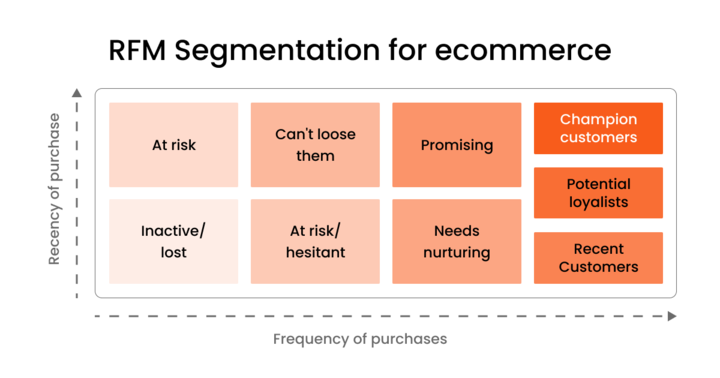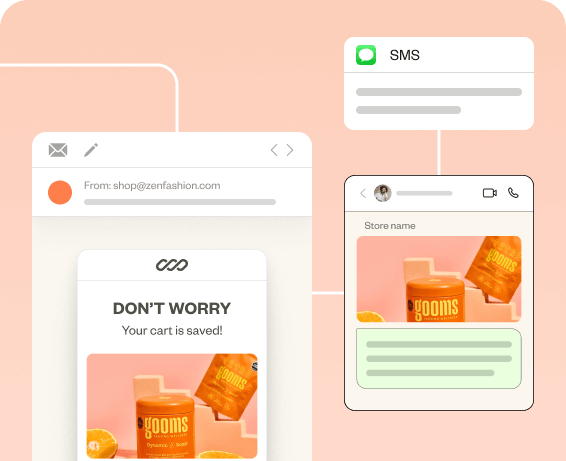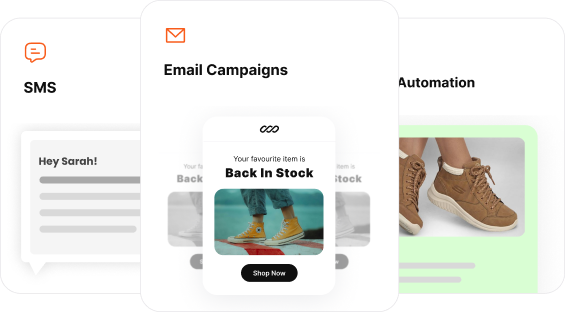Receiving irrelevant emails at a random hour will frustrate people. That’s why, neglecting email marketing frequency best practices results in higher unsubscription rates, and lower email deliverability. Moreover, it can damage your sender reputation too.
One of the best ways to ensure engagement is by following email marketing frequency best practices. When you send and how often you send decides if you’re annoying your audience or keeping them informed.
In this blog post we have shared:
- What the best email frequency is
- Challenges in high and low email frequency
- 10 best practices for email marketing frequency
Optimize email frequency effortlessly using Retainful’s smart triggers and automation to maximize engagement.
What is Email Frequency?
Email frequency refers to how often you send emails to your subscribers. However, the right email marketing frequency for your business varies depending on your industry, audience behavior, and email content.
In email marketing, sending too many emails can lead to unsubscribes, and too few emails may affect the engagement rate.
However, a good email frequency is 2-3 emails per week. Eventually, you can optimize your email cadence (frequency and timing) based on your subscribers’ preferences.
Here is a table listing the best email frequency based on the email type:
| Email Type | Best Email Frequency |
| Newsletter | Once a Week Weekly newsletters show consistent engagement and reduce unsubscribes. |
| Marketing Emails | 1-3 emails per week |
| Transaction Emails | Transactional emails need to be sent instantly after a trigger (user actions). |
| Welcome Emails | 2- 3 emails in a week |
| Abandoned cart recovery emails | 2- 3 within 48 hours |
| Reengagement emails | 1-2 emails within a week |
Frequency Challenges in Email Marketing Campaigns
The core challenge in email marketing campaigns is the dilemma “am i sending emails too often or not enough”. It’s clear that there is no one number for the best email frequency. There are challenges associated with both the extremes.
The challenges that come with high email sending frequency are:
- Increase unsubscription rate: It is the most direct and damaging consequence of sending emails too often.
- Decreased Open Rate: Even if subscribers don’t unsubscribe, they might start ignoring your emails. A good open rate for email campaigns is 17%. If you’re surpassing this benchmark, your frequency is right.
- Lower CTR: If your emails are not opened, your CTR will plummet significantly.
- Damaged Sender Reputation: Lower engagement signals ISP that your emails are unwanted. It affects your email deliverability. Moreover, it can result in your emails going to spam.
The challenges that comes with low email sending frequency:
- Decreased Brand Recall: If you’re not consistently present in the inbox, subscribers will forget about your brand.
- Missed Conversion Opportunities: Infrequent sending means fewer chances to promote products, and drive traffic to your website. It directly impacts sales and lead generation.
- Stagnant List Growth: An email list that isn’t regularly engaged can become “cold.” While you might not see unsubscribes, you’ll see a decline in active subscribers.
Related Reading: 11 Best Ecommerce Email Templates + Examples.
10 Email Marketing Frequency Best Practices
Low email frequency means risk missing out on engagement and getting loyal customers. On the other hand, sending emails too often can frustrate subscribers.
To overcome these challenges you need email marketing frequency best practices.
Here is a list of 10 best practices for email marketing frequency:
- Know Your Audience
- Segment Your Email List
- Personalize Every Email You Send
- Try Different Variations of Your Email
- Vary Your Content And Value Proposition
- Start With Industry Benchmark
- Be Consistent And Build Anticipation
- Give Control to Your Audience
- Test Different Email Cadence
- Monitor Performance
1. Know Your Audience
Understand how often your audience would like to hear from you. It is the key factor in email marketing frequency best practices. Keep track of your customer’s buying cycles, behavior pattern, engagement level.
This way you can identify when and how often you can send your emails. Moreover, having a good understanding of what content your contacts respond to can help you in creating relatable content.
To understand your audience:
- Track open rates, clicks, purchase history, engagement level.
- Use surveys or onboarding forms to ask how often they want to hear from you.
2. Segment Your Email List
Segmentation is the most used email marketing strategy. It is natural to have different types of audiences in your email list. So, it’s important to segment your email list to send targeted emails.
Why You Should Segment for Email Frequency:
Segmentation lets you send emails on varied frequencies for different segments.
For example, a first-time shopper may need more frequent emails than loyal customers to guide them toward conversion.
How to Segment for Email Cadence:
- Email marketing funnel: Adjust frequency based on where subscribers are in the email marketing funnel.
- Awareness and Consideration: Send nurturing content 2–3x per week to build trust.
- Decision Making: Comparison, testimonial, and offer-based emails weekly.
- Loyal customers and Brand Advocates: Time-sensitive offers or reminders with higher frequency.
- Engagement Level: For a highly engaged segment, send 3+emails per week. Retarget low engaged and dormant users with 2 to 3 emails per month.
- Demographic Segmentation: Age, gender, job title, or industry can affect how often someone wants to hear from you.
- Behavioral Segmentation: Use behavioral data to trigger relevant messages at the right time (e.g., back-in-stock emails, reorder reminders, cart recovery emails).
- Geographical Segmentation: It lets you send emails at the right time zone and seasonal holidays. You can schedule emails to land during high engagement hours. Moreover, you can adjust frequency for region-specific discount emails and local holidays.
- Use RFM Method: RFM segmentation helps identify your most valuable customers. For high RFM scores increase email frequency with VIP deals. Whereas for low RFM use spaced-out engagement emails.
- Recency: How recently they purchased.
- Frequency: How often they purchase.
- Monetary: How much they spend.

Discover multiple segmentation criteria and templates in one place at Retainful and launch your targeted email campaigns in minutes.
3. Personalize Every Email You Send
If you are sending irrelevant emails, even one email per month can feel like too much. But if you send personalized emails, your subscribers will welcome more frequent communication.
With the right personalization strategy and consistent schedule your emails are looked forward to. Every email becomes a high impact touch-point.
Why email personalization is important for email cadence:
Email personalization is a key driver in determining how often you can safely show up in your subscriber’s inbox.
Without personalization, even a small increase in email frequency can lead to lower engagement, and email fatigue.
Here’s how you can personalize your emails:
- Use dynamic fields to include customer details, purchase summary, dynamic coupons and even email images.
- Trigger emails based on actions like cart abandonment, product views, or past purchases.
- Send curated information, product recommendations based on your audience interests.
- Deliver emails based on each segment’s peak active hour.
- You can even send review request emails and referral emails with personalized discounts to your high value customers.
4. Try Different Variations of Your Email
There’s no universal email formula that works for every audience. To find the right frequency, you need to adjust both how often you send emails and what content you include.
Here’s how to test email variations for better frequency control:
- Test different elements: Try variations of CTAs, subject lines, content formats, email design to see what drives engagement.
- Email Layouts: Stick to your brand tone but experiment with short vs. long-form content, and visual-heavy vs. text-based formats.
- Vary frequency across segments: Some users may respond well to daily tips, while others prefer weekly updates.
- Test email types: Alternate between promotional, educational, and value-based content to prevent fatigue.
5. Vary Your Content And Value Proposition
Sending the same type of email repeatedly even if it’s well-timed can lead to low engagement. To keep them engaged at any frequency, your emails must deliver varied content and fresh value.
Ways to vary your content and value proposition:
- Alternate between promotional and educational emails. Don’t just sell, but also solve problems. This way, you can establish yourself as a niche expert.
- Showcase different product categories or use cases to appeal to diverse interests and audience segments.
- Change your value proposition with exclusive perks, time-sensitive discounts, early access and product launch tickets to create excitement.
- Share customer stories, behind-the-scenes, UGC and how-to guides to build a stronger connection.
- Align content with your email segments so each group receives value based on their interests.
6. Start With Industry Benchmarks
Following industry standards for email cadence is a safe way to get started with email marketing.
According to Hubspot, weekdays perform better than weekends. Emails sent on Monday, Tuesday, and Wednesday mornings get the most engagement.
Depending on your niche and audience your optimal email cadence can deviate. Here is a table consisting of optimal email frequency for specific industries.
| Industry | Optimal Email Frequency |
| Fashion Industry | 2-5 emails per week. Increase frequency during new drops and flash sale. |
| Custom Decor | 1-3 emails per week |
| B2B Saas | 1-2 emails per week |
| Hospitality | Monthly emails |
Related Reading: 10 Best eCommerce Thank You Email Templates and Tips.
7. Be Consistent And Build Anticipation
When it comes to email marketing frequency best practices, consistency often gets overlooked. Sticking to a proper schedule (monthly or weekly) builds predictability and anticipation.
A consistent schedule builds brand recognition and habit. Moreover, it improves email deliverability since ESPs prefer consistent senders. Consistency prevents your brand from being forgotten.
If you have promised weekly emails, stick to this schedule and send weekly emails consistently. It shows your reliability and builds trust. You can schedule your emails using automation workflows to improve efficiency.
Related Reading: 11 Email Automation Best Practices to Send Tailored Email Campaigns.
8. Give Control to Your Audience
Best way to find optimal frequency is to let your subscribers choose how often they want to hear from you.
In the signup form , explicitly mention how often they will receive emails from you. This way, you can set the right expectations.
How to implement:
- Add a preference center so users can select email topics and frequency.
- Include frequency options during signup (e.g., weekly vs. monthly updates).
- Let subscribers pause or snooze emails without fully unsubscribing.
- Use past engagement to adjust frequency. Send less if open rates drop.
9. Test Different Email Cadence
How to find the best email frequency for your customers if you don’t test. What works for other businesses may not work for you. Email frequency working for one segment does not necessarily work for other audiences.
This is exactly why you need to test with different email cadence across all your segments. You can test different sending intervals, days, and time.
Moreover, you can use time-based and behavior-based triggers to personalize delivery timing. To send trigger-based emails use email automation.
10. Monitor Performance
Finding the right email frequency isn’t a one-time task. It’s an ongoing process. You need to track performance regularly and adjust based on real data. With the optimal email cadence you can significantly reduce your email marketing cost.
Key metrics to watch:
- Open Rate – Optimal email frequency
- Click-Through Rate (CTR) – Indicates engagement
- Unsubscribe Rate – Shows that you’re overmailing
- Spam Complaints – Signals poor targeting or excessive frequency.
- Conversion Rate – Tells you whether your emails are actually driving results.
Launch personalized email campaigns at the right time using Retainful’s smart triggers and target feature to increase conversions effortlessly.
Final Thoughts
Following email frequency best practices is the most underrated ecommerce marketing strategy. With an optimal email cadence and email marketing best practices you can effortlessly grow your email list and increase ROI.
To run email campaigns with optimal sending frequency, you can use email marketing tools like Retainful.
With Retainful you’ll get access to:
- Pre-built automation workflows
- Advanced segmentation capabilities
- Trigger-based targeted email campaigns
- 150+ Pre-designed email templates
- Smart double opt-in popups
Also Read
- 10 Email List Management Software + Best Practices
- How to edit the WordPress email template? + Plugins
- How to make money with Email Marketing (10 Proven Ways)
Frequently Asked Questions
Start with 1–3 emails per week, then adjust based on audience engagement and unsubscribe rates.
Segment your audience, personalize content, and test different cadences to find what works best.
If open rates drop or unsubscribes spike, you’re likely sending too many emails. Monitor your campaign performance closely.
Yes, over-emailing can lead to spam complaints and damage your sender reputation.
Yes, engaged users can handle more emails, while inactive ones may need less frequent contact.
Yes, during peak seasons you can increase frequency. Just keep the emails relevant and value-driven.
Most ecommerce stores send 2–3 emails per week, including newsletters, promos, and cart reminders.
Offer a preference center where users can select how often they want to hear from you.



